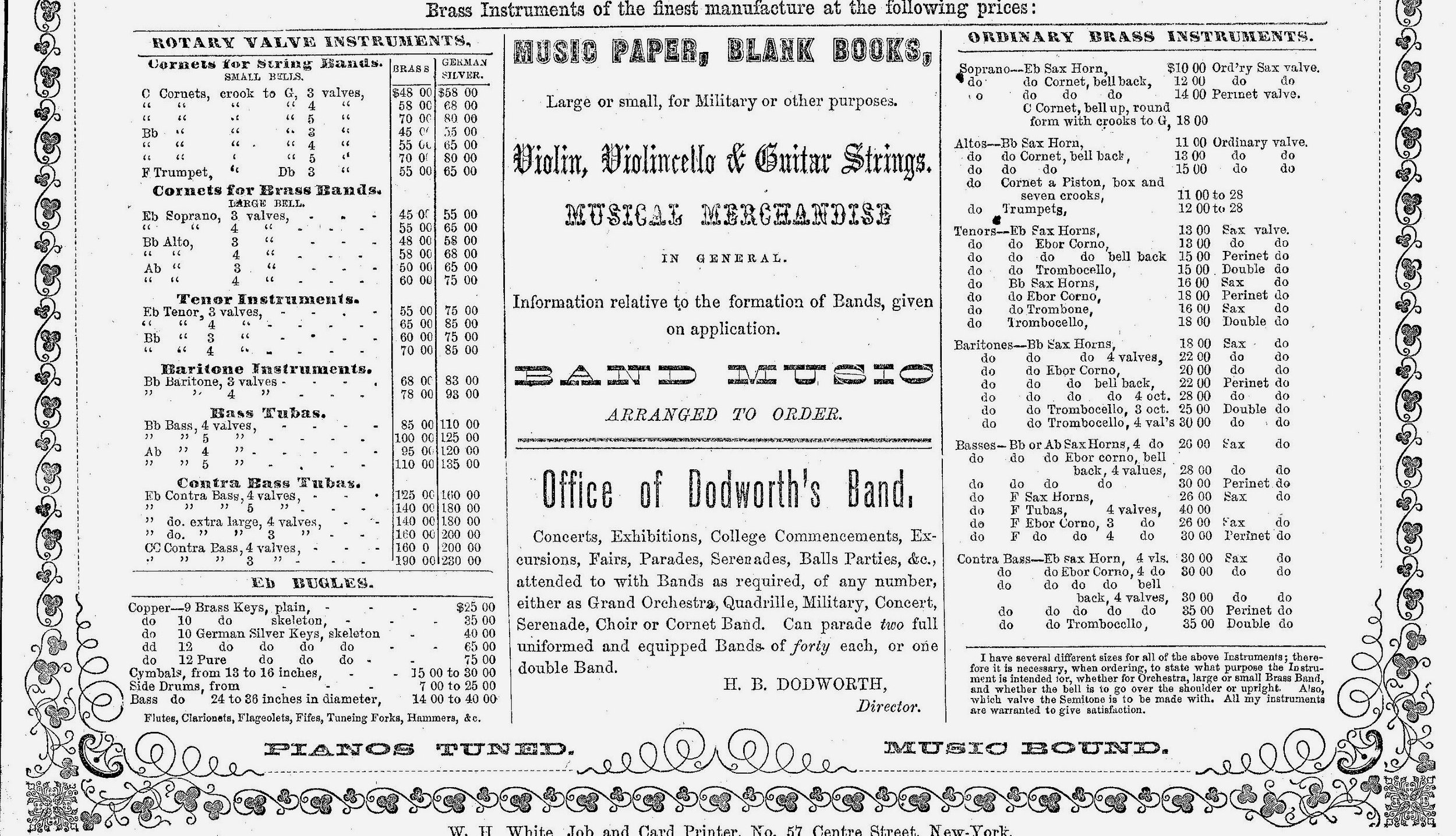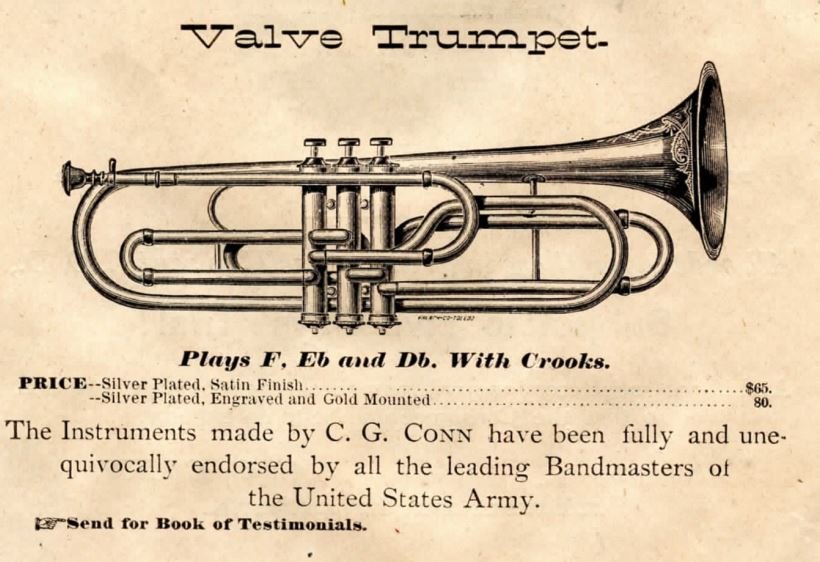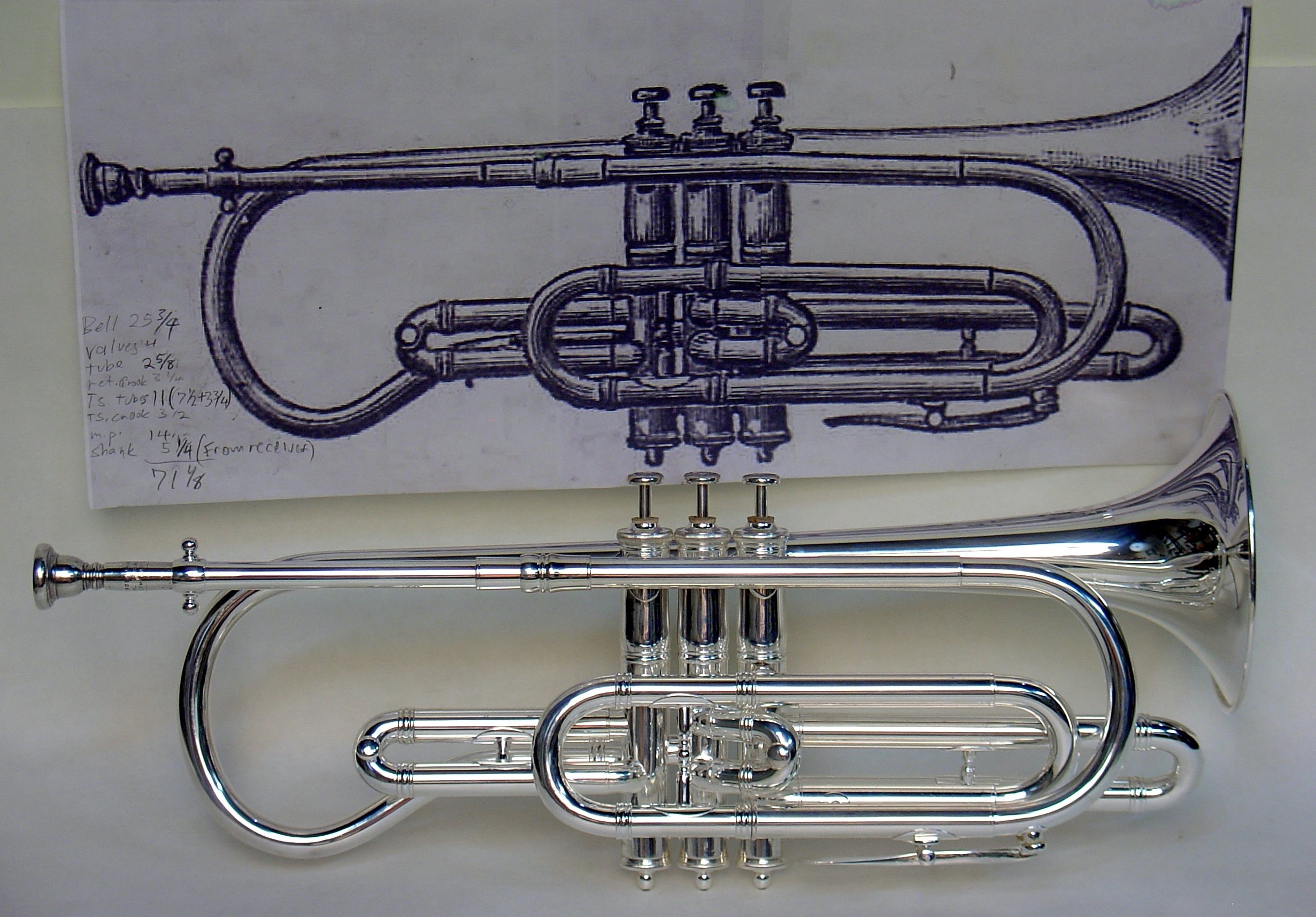Boston F Trumpet
We don't have any evidence of what trumpets were made by Boston Musical Instrument Manufactory during its first decade of operation, although a price list published in about 1863 by their predecessor, E.G. Wright offers "F and Eb Trumpets, Three Valves" in either brass or nickel silver, but without further explanation. No example of this model is known, but it seems a sure thing that they were made with rotary valves as in all of Wright's instruments at that time.
List of instruments available from E.G. Wright in about 1863.
The earliest known example of an American made valve trumpet in F is by James Keat for Graves & Co. about 1840, in Winchester, NH. This instrument is in the Utley Collection of the National Music Museum. It is made on the pattern made in Paris in the 1830s and no others by an American maker are known. In his 1856 list of instruments for sale, Harvey Dodworth offers "F Trumpet, Crooks to Db, three (rotary) valves" in either brass or German silver. It seems likely that these were American made, based on the higher prices than the obvious imports listed under “ORDINARY BRASS INSTRUMENTS”, although there is no way of knowing the maker for sure. It could have been Fiske, Wright or Allen or more than one of them.
Listing of instruments available from Dodworth in 1856.
We also know that C.G. Conn was offering trumpets in F by 1881, based on an offering in their catalog that year.
Listing from Conn’s 1881 catalog.
While it is most likely that Boston continued making the Wright designed trumpets, they are not listed in the 1869 or 1874 catalogs. Thet would likely have been available by special order, not popular enough to list. It is likely that the newly designed trumpet with piston valves would have been developed in the late 1870s or early 1880s, during the time that they were developing new cornets with the same piston valves. The earliest evidence that they were offering this trumpet for sale is as published in their 1881 catalog. It is illustrated with a wood cut engraving and is described as being in F with crooks for E, Eb, D and C.
In the listing from the 1887 catalog, it appears with the same cut and description, but is also available in Bb with crooks to A and Ab. The smaller instrument isn't illustrated and none are known to survive, but it might have also shared the "shepherd's crook" bell design. These catalogs mention that their trumpets were used in the (Georg) Henschell concerts (in 1881, the first conductor of the Boston Symphony Orchestra) and Thomas Orchestra (of New York, which later became the Chicago Symphony Orchestra) although we have no other information about their use.
Listing from Boston’s 1887 catalog.
They continued offering trumpets in these two pitches in their catalogs in 1904 and 1915. The illustration is the Bb trumpet without "shepherd's crook" bell or terminal crooks, although it still appears to utilize the same valve assembly design as the Three Star cornets. It then only had "Crooks" to A. The F trumpet only had crooks to E and Eb. The second illustration here is from the latter catalog.
Listing for trumpets in Boston’s 1915 catalog.
The photo below shows the only Boston trumpet known that was made before 1915, in Tom Meacham’s collection and was made in about 1903. This example confirms that the valve section is the same as in the Three Star Cornets and careful measurements confirm that bell design is also the same.
Only known example of early Boston trumpet in Bb.
1915 must have been the last year for the F trumpet; the 1916 supplement to that catalog introduced a new, more modern Bb trumpet and the larger instrument was no longer mentioned.
It is interesting that the earlier catalogs call this (F trumpet) "Orchestra or Band Trumpet". While it is an appropriate instrument for the 19th century orchestras, I know little of the use of such trumpets in American bands. The important exception, is the Patrick Gilmore's band, that utilized two or three Courtois F trumpets crooked to Eb. J.P. Sousa and other composers for military bands, included parts for field trumpets in F and G (this is what we call "US Regulation" bugles today), but I am not aware of the use of the lower pitched valve instruments used in these later bands. It would only seem to be for adding the old fashioned sound of the earlier trumpets and would be an inferior choice for playing the alto parts in bands; Boston made several excellent alto horns including the pocket solo alto, which was more compact than the trumpets.
It is also possible that they wanted to avoid missing a sales opportunity and there were many bands in the US formed by immigrants that were following their European traditions. I do know that Keefer was oddly marketing their Eb trumpet (lengthened version of the Distin orchestral F trumpet) for use in dance bands in the late 1910s, which is a difficult concept to grasp.
The strongest influence on the increasing popularity of trumpets in the US before 1915 was certainly Sousa's Band, which started using a pair of Bb trumpets in the 1890s and other professional bands followed their lead. Gilmore's band had a pair of trumpets by the time of their 1878 European tour and I believe that they were F trumpets crooked to Eb, since in an 1885 newspaper article about the band's instrumentation mentions three trumpets in Eb and in an 1889 photo of the band, a Courtois style F trumpet is visible and appears to have an Eb crook in place. While the Gilmore and Sousa bands had a profound effect on popular music in this country, the trumpet was not included in most of the thousands of city, company and military bands and Boston must not have sold many of these trumpets in the 35 years that they were available.
I first became aware of this model when I bought a copy of the 1887 catalog in about 1988, but I have never seen or heard of an original F trumpet made by Boston. The serial numbers would be 20,000 or lower. Please let me know if you have one or have heard that one exists.
I have always been intrigued by these trumpets and have studied the engraved image often. It appears to have the same valve section that was used in the Boston Two and Three Star cornets and while there's no way of knowing the bore measurement, I would assume that it would not be the larger (.485" or .487") used in the Two Star, but rather .472" as used in the Three Star or possibly .462 as in the C cornets. Also, the 1903 Boston trumpet in Bb has the same .472” bore valve section used in the Three Star Cornets.
It was not much of a mental leap to think that I could reconstruct a Boston F trumpet using as many parts made by Boston as possible. I already had several parts horns (Three Star cornets) around and one of these had a valve section that needed the pistons plated and refit and otherwise very repairable. The usable original parts include the valve assembly, the three valve slide crooks, the tuning slide crook, the return crook between the tuning slide and third valve, all the large ferrules, the waterkey assembly and all the braces. The longer tuning and third slide tubes would have to be made new as well as the bell and entire mouthpipe assemblies.
I knew from previous experience, including reconstructing a Boston echo cornet, that the engravings in the Boston catalogs are surprisingly well scaled to the actual instruments. Just as in the echo cornet project, I printed out a full size image of the trumpet, based on the known dimensions of the Three Star valve section. If I was right, the measurements taken from this would be close to those of the actual instrument and this was indeed the case.
Reconstructed trumpet below enlarged catalog image with dimensions.
I did some experimentation with various bells that I knew I could get from Kanstul Musical Instruments and ordered the one that worked best with a 5 1/4" rim, which is approximately what it measured in the print. This was bent using the print as a guide; the overall length of the instrument ended up at 16 7/8" and then it was sent off to Kansas to be engraved by James McKenzie. I made a special mouthpipe appropriate to the design and the shank for F and a crook for Eb.
Right side of reconstructed Boston F trumpet with shank for F and crook for Eb.
The completed trumpet is as good playing as any F trumpet that I have come across and could easily be used for the performance of 19th century orchestral literature. It has a sound similar to original natural trumpets and English slide trumpets, but the response and technique is much simpler. I've photographed it with a Boston trumpet mouthpiece from about 1920, but to take best advantage of the richness of this trumpet's sound, a much larger mouthpiece should be used. The Schilke 20 mouthpiece that I almost always use for testing trumpets works very well and any very large modern mouthpiece would likely be an excellent compromise for a modern player.
Left side of reconstructed F trumpet.
I also tested it with a number of early trumpet mouthpieces, including the original from the Brown & Sons F trumpet. The Brown mouthpiece produced a beautiful sound, but made it difficult for me to play cleanly. The best of the antique trumpet mouthpieces that I have on hand is a French Besson from some time between about 1880 and 1900 that likely was originally supplied with their "Military Trumpet in F". This has a very large rim diameter and hole but still didn't get results as good as the modern one that I'm accustomed to.









